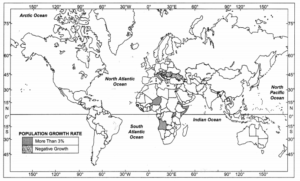1. Choose the right answer from the four alternatives given below:
(i)
Which one of the following continents has the highest growth of population?
(a) Africa
(b) South America
(c) Asia
(d) North America
Answer:
(a) Africa
(ii)
Which one of the following is not an area of sparse population?
(a) The Atacama
(b) Equatorial region
(c) South-east Asia
(d) Polar regions
Answer:
(c) South-east Asia
(iii)
Which one of the following is not a push factor?
(a) Water shortage
(b) Medical/educational facilities
(c) Unemployment
(d) Epidemics
Answer:
(d) Epidemics
(iv)
Which one of the following is not a fact?
(a) Human population increased more than ten times during the past 500 years.
(b) It took 100 years for the population to rise from 5 billion to 6 billion
(c) Population growth is high in the first stage of demographic transition.
Answer:
(c) Population growth is high in the first stage of demographic transition.
2. Answer the following questions in about 30 words:
(i)
Name three geographical factors that influence the distribution of population:
Answer:
Availability of water: It is the most important factor of life. People prefer to live in areas where fresh water is readily available. Water is essential in development of agriculture and carrying out day-to-day activities.
Land forms: People prefer to live in flat plains and gentle slopes as they are favorable for the production of crops and in building roads and industries.
Climate: People prefer living in areas that do not have extreme climatic conditions that is areas that do not have high diurnal and annual range of temperature and also which have adequate rainfall.
Soils: Fertile soils are important for agricultural and allied activities. Therefore, areas which have fertile loamy soils, have more people living on them as they can support intensive agriculture.
(ii)
There are a number of areas of high population density in the world. Why does this happen?
Answer:
The areas with high population density across the world have at least one or usually multiple factors favorable for the settlement of population. Wherever people found conducive conditions for living, they have been settling there. With passage of time and growth of population, these areas became regions of thick population density. For example, the regions with availability of water, good climate, presence of minerals and other resources, of religious or cultural significance became regions of thick population. Example: Ganga-Yamuna Doab, Mediterranean regions.
(iii)
What are the three components of population change?
Answer:
The three components of population change are:
Crude Birth Rate (CBR): It is expressed as number of live births in a year per thousand of population in a particular region.
Crude Death Rate (CDR): It is the number of deaths in a place per thousand of population in a particular region. CBR and CDR are natural factors of population growth. They result in natural population growth, which is equal to the difference between CBR and CDR.
Migration: It is the induced factor in population growth. It is the number of people moving in and out of a place due to various social, economic and political reasons. It is taken into account while calculating actual growth of population.
3. Distinguish between:
(i)
Distinguish between Birth rate and Death rate:
| Birth Rate | Death Rate |
| It is the number of live births per thousand of population during a year for a particular region | It is the number of deaths per thousand of population during a year for a particular region |
| It is calculated using the following formula: CBR = Bi/P xlOOO Here, CBR = crude birth rate, Bi = Number of live births in a year, P = the estimated midyear population of that year. |
It is calculated using the following formula: CDR= D/P xlOOO Here, CDR = crude death rate, D = Number of deaths in a year, P = the estimated midyear population of that year |
| If birth rate is more than death rate, it results in positive growth of population. | If death rate is more than birth rate it results in negative growth of population. |
(ii)
Distinguish between Push factors and pull factors of migration:
| Push factors | Pull factors |
| These factors are the ones which makes a place less attractive for human settlement. | These factors are the ones which makes a place an attractive destination for settlement. |
| These factors forces people to move out- hence face emigration. | These factors force inflow of people – hence face immigration. |
| Examples: Unemployment, poor living conditions, political turmoil, unpleasant climate, natural disasters, epidemics and socio-economic backwardness. | Examples: Better job opportunities, better living conditions, peace and stability, security of life and property and pleasant climate. |





